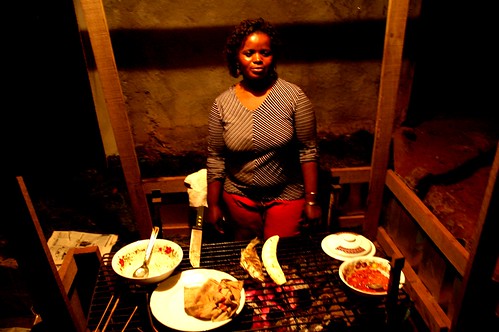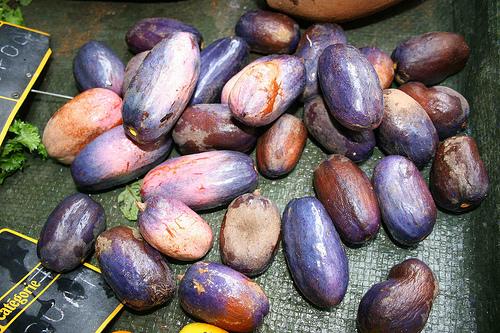Those of you that know me well enough know that I am not one for fast food. The closest I get to eating fast food in the U.S. is the occasional slice of pizza or deli sandwich. I've made a much belated discovery, however, that I am a Cameroonian fast food junkie. It's not that I just discovered liking the foods I prefer here, but rather that I just came upon the realization that they all fit into the category of "fast food" (not necessarily what you'd call it in Cameroon).
So, without further ado, Cameroonian fast food at its best:
Poisson Braissé: Simply put, grilled fish. And though this meal is a simple one, it is, by far, my favorite thing to eat in Cameroon. The system is beautiful. When the craving hits, find a nearby bar. If it's after noon, and you're in a reasonably sized town or city, you're likely to find at least one bar, outside of which will be a woman (or several) preparing fish over a small charcoal grill. You size up the fish. Whole fish, heads of fish, tails of fish. You choose. The fish are basted with a delicious mixture of peanut or vegetable oil and "
condiment vert" (basil, parsley, celery, green pepper, garlic - LOTS OF GARLIC) and roasted to a perfect, browned crispiness. Once you've negotiated the price for the piece you want (usually about 250-300 f CFA for a half fish and 400-700 f CFA for a full fish, depending on size - at about 445 f CFA per US$), you indicate how much
baton de manioc, and maybe even
fried plantains you want with your meal, and then indicate in which bar you intend to sit. Take your seat, order a beer or soda, watch some football/soccer, and before you know it, your platter has arrived, along with a bowl of water for hand washing. Your fish comes with a garnish of red onion slivers - delicious - and two puddles of
piment (hot pepper sauce) and
condiment vert (the same deliciously garlicy concoction used to baste the fish). Wash your hands, and dig in. No utensils needed. Just pull the delicious meat right off the bones. Yum.
Now, more about the accompaniments:
Baton de Manioc: Literally translated: Cassava Sticks.
Cassava, as many of you know, is a tuber eaten all over the world, but particularly in Latin America and Sub-Saharan Africa. Alex and I had the pleasure of getting a thorough lesson in the making of
baton (it was my second lesson, though I needed a refresher) because we are intent on making it in the U.S. Essentially,
baton de manioc consist of casava starch that has been soaked for days to soften the tubers and detoxify the starch. The softened starch is then run through a grinder and then the pulp is laid out and rolled intobanana leaves, which are then tied shut with string. The tied
baton are then cooked in boiling water until the soft white pulp has stiffened and turned slightly translucent. Once the baton have cooled, the leaves are simply peeled and discarded, leaving a slightly sticky starch, somewhat the consistency of licorice. Dip in
piment and/or
condiment vert and enjoy.
Fried Plantains: Not much mystery here. Slice sweet, ripe plantains in long strips or on a diagonal, drop into hot peanut or vegetable oil, fry until browned, and enjoy. I'll admit to having an incredible weakness for fried plantains - and seemingly a second stomach devoted solely to their consumption, which never seems to fill. Ripe plantains can also be grilled, another common form of street food. Both ripe and unripe plantains are boiled, as well, and eaten with sauces, but this type of preparation doesn't fall under the category of "fast food."
Other Cameroonian street food:
Les Prunes: Commonly referred to as
prunes, the
African Plum or Safou is a unique fruit that, in my mind, fits somewhere between an avocado and an olive. Slightly sour in taste, the fruit has a purplish (edible) skin covering a thin layer of greenish gray flesh, with a large, soft pit in the middle. Prunes are grilled, often alongside plantains and fish.
Soya: In short, meat on a stick. Small pieces of beef, basted in broth, and grilled on street. Served with powdered
piment. Typical bar food.











